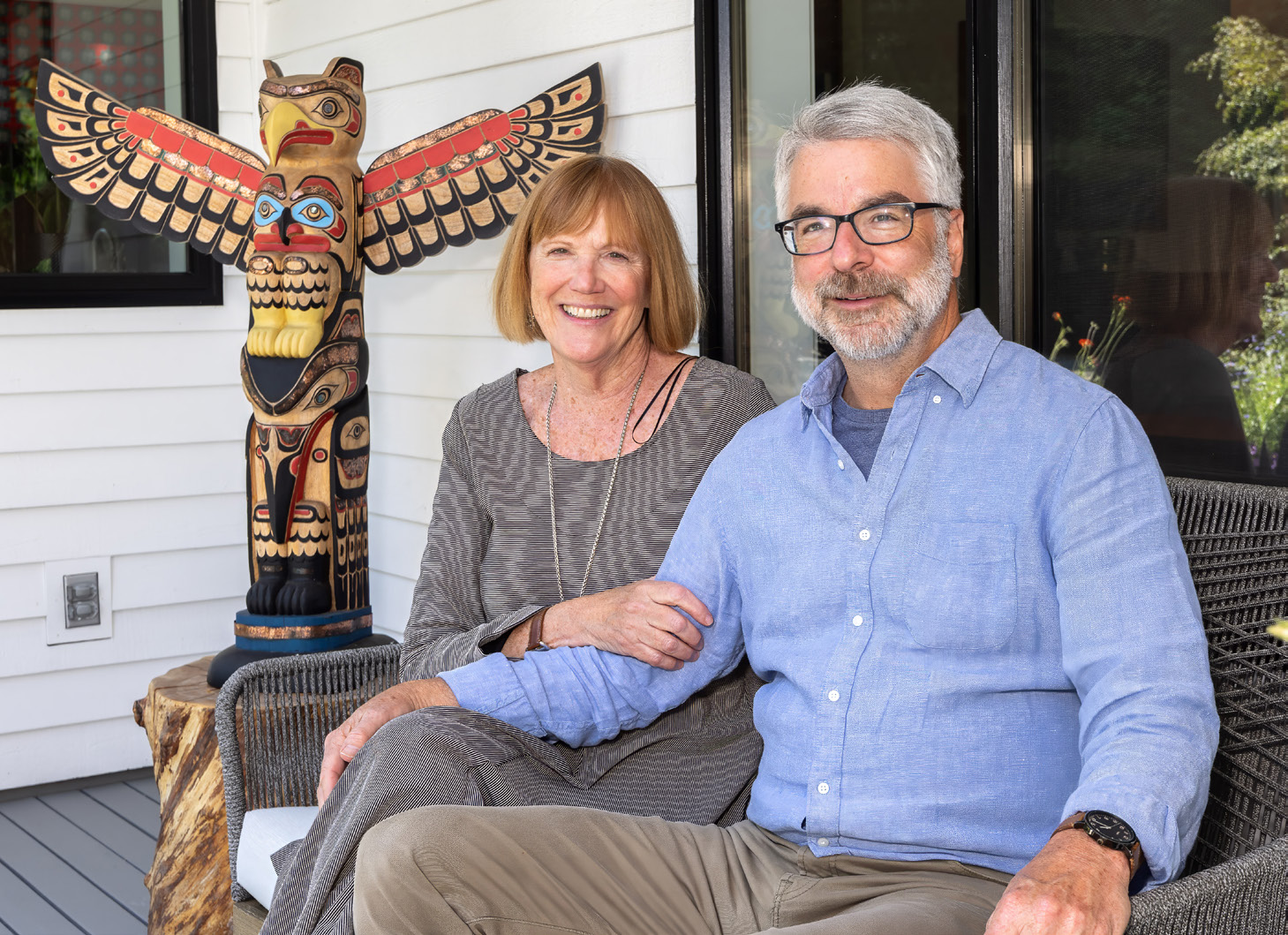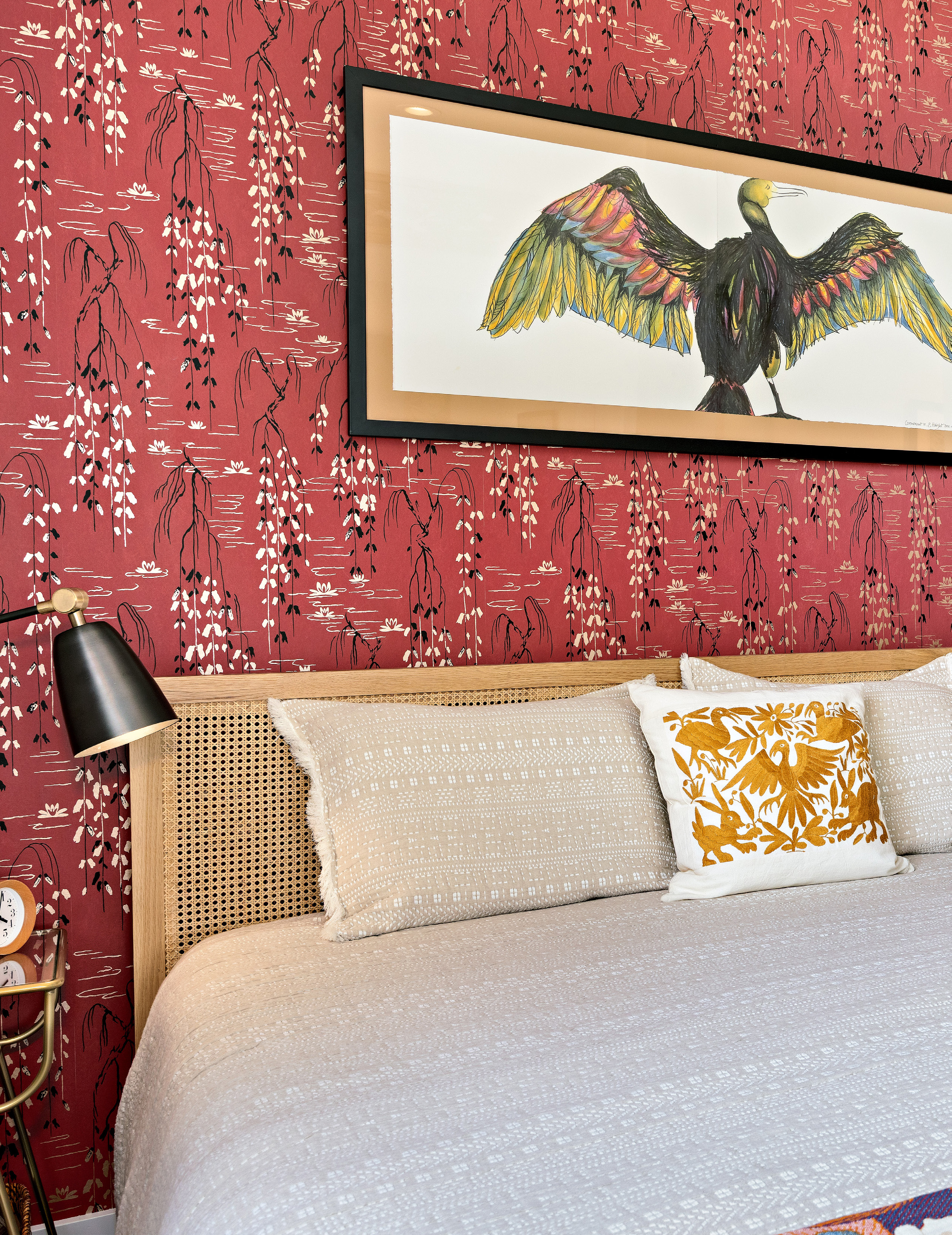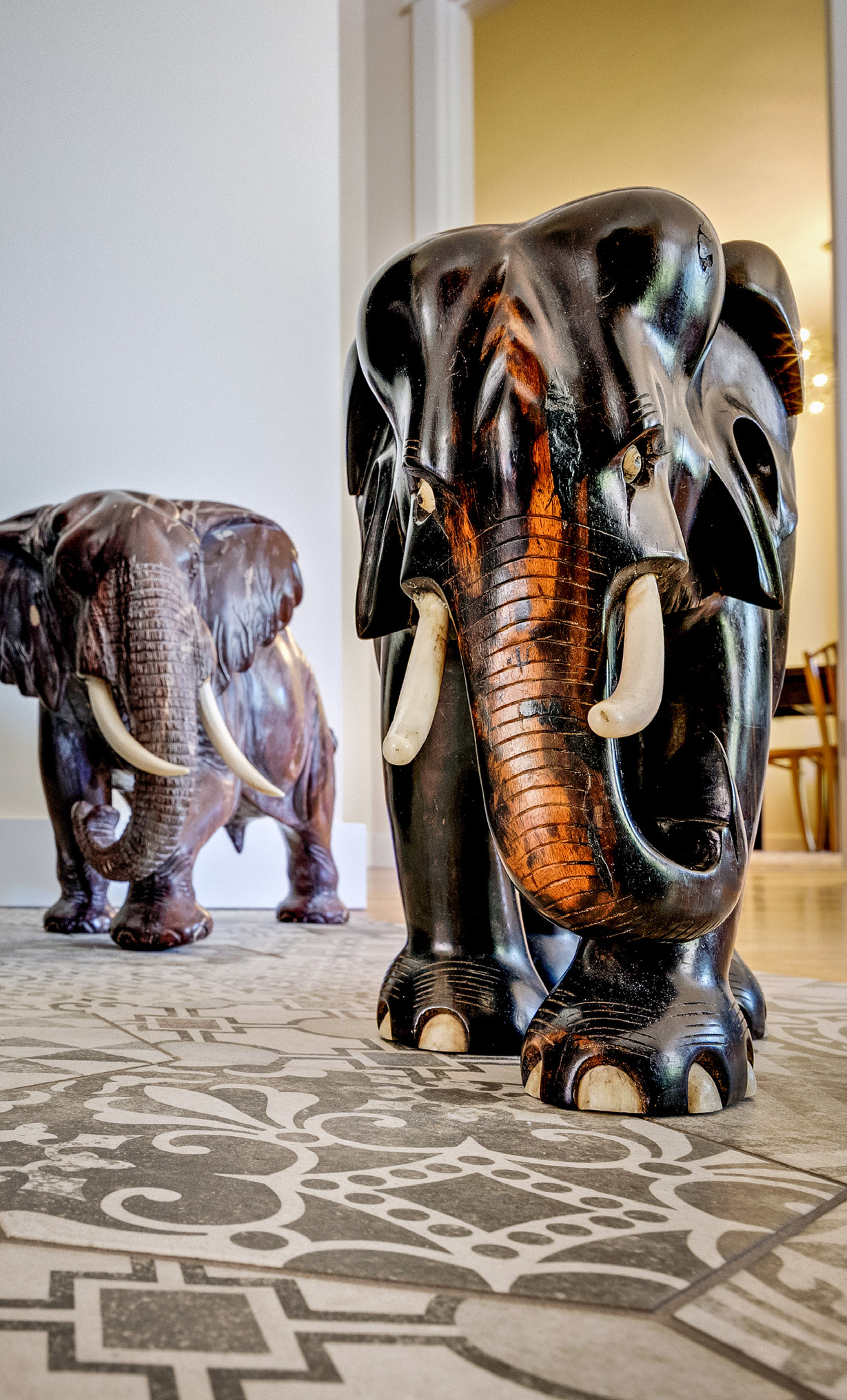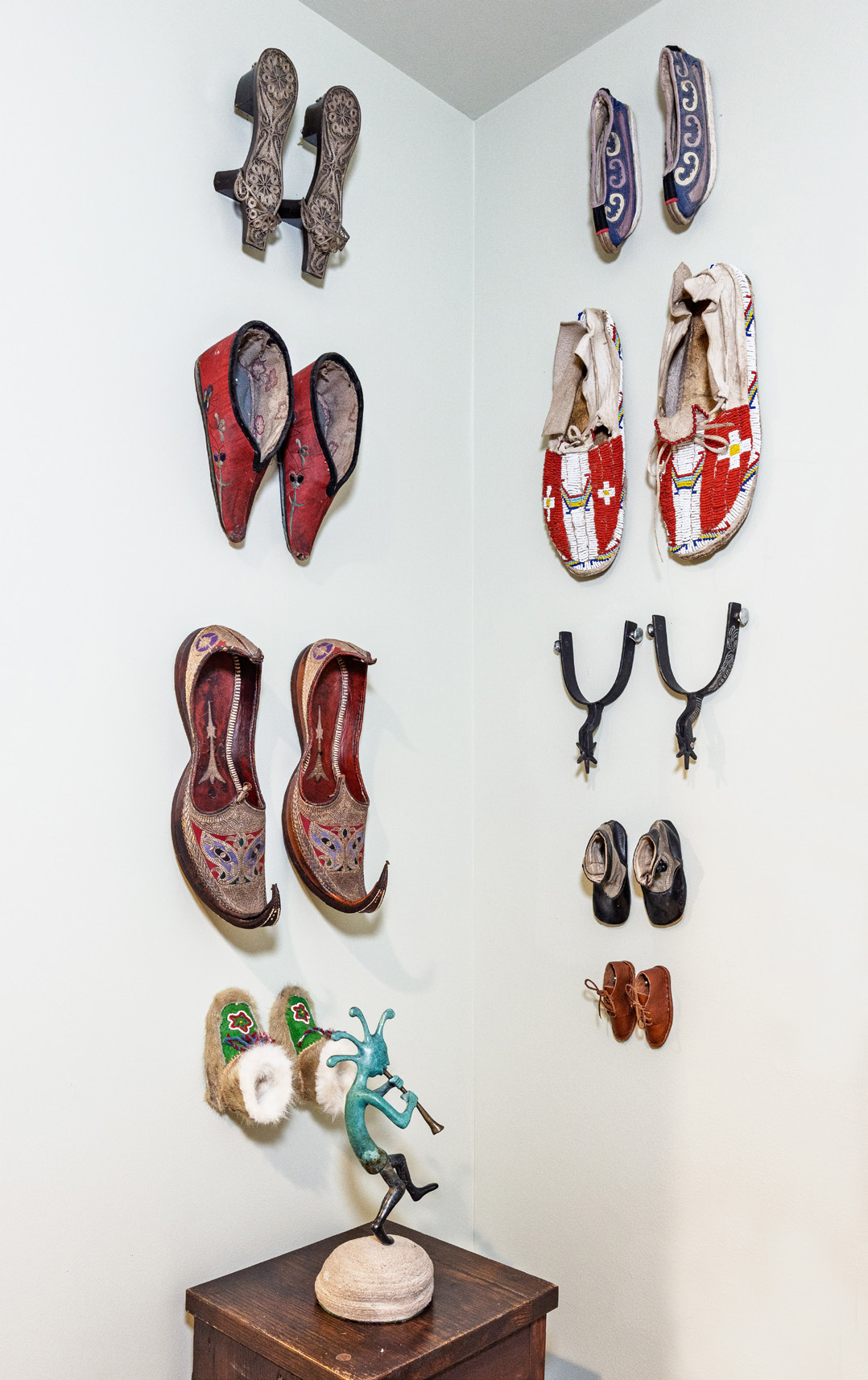HER HAPPY PLACE
Sunrise Home Becomes a Collector’s Canvas
by Alli Schuchman
photos by Kelvin Hughes
Anne Reusché, a philanthropic communications consultant, said she first “discovered” Bainbridge in 2015 while working for Bloedel Reserve on an early campaign.
Over the next five years, she and husband David Marzahl, an executive coach, returned frequently, in every season, to be certain that the island resonated as deeply as it had initially, when Reusché had returned home to Evanston, Illinois, declaring, “I know where we’re gonna live.”
With due diligence under their belts, in 2020, at the height of the COVID pandemic, the couple moved to Bainbridge, leaving behind their adult kids, son Kiel and daughter Lily, as well as Lily’s daughter, Gabby, who’s now 8 years old and who spends every summer on the island with her grandparents.
Reusché and Marzahl bought a home off Sunrise Drive, and although it’s lovely by every measure, it’s what’s inside—in every conceivable space and on every wall—that makes the home exceptional.

Take for instance the downstairs powder room. Nine pairs of footwear hang in two neat vertical rows. Among them: a geisha’s geta, Tribal slippers and a horseman’s spurs; shoes from Turkey, Vietnam, China, England and Spain. They share a form, yet each carries its own story—of the maker, the wearer and the journey that brought them to a small island in the Pacific Northwest.
Much like the shoes, Reusché and Marzahl’s home is a story about integrity and convergence: of past and present, of distinct origins woven into a cohesive whole. The imagined permutations of more than a thousand works of art within a single meaningful collection is nearly inconceivable, yet despite the incalculable odds, they’ve landed in perfect harmony.
Reusché said the inspiration for their collection—and its collecting—was in part motivated by the challenge of selling, donating and transporting their belongings during the pandemic. Armed with a keener relationship to possessions, the couple committed to a more intentional approach, resolving to source everything possible locally for their new home.
They came impressively close.
“From the mattresses to the artwork to the furniture,” Reusché said, “probably 80 percent came from Bainbridge; the rest from Seattle, with a few cherished family heirlooms mixed in.”
What began as a practical constraint evolved into something far more fulfilling—a treasure hunt that became deeply personal. Reusché said it helped forge a lasting connection to the land, the artisans and the community that the couple now calls home.

Furnishing the home—or the canvas as Reusché refers to it—was neither quick nor easy. “It was a labor of love with a focus on labor.” But as Reusché tiptoed into the challenge, visiting local antiques stores, resale shops and estate sales, one connection led to another, and her network began to grow.
“The people that I got to know, who were like-minded about vintage or collectibles, would send me to different places,” she said. “That’s how I met friends and then more community. The people who really got into it with me—the house, the collections, the whimsy—are absolutely a reflection of the joy of living on this island.”
The home’s joy is clear. The initial piece that Reusché referenced (the first of her “happies” as she likes to call them) is a photograph. “This was the first photo we took on the island,” she said. The framed black and white print is of the unassuming, but unmistakable, moss-covered bus shelter at Highway 305 and Koura Road. “To me, this was the start of collecting on Bainbridge.”
Next, Reusché turns to an assembly of five circular pieces hanging on the home’s east wall. “I think it’s the juxtaposition that makes me happy,” she said. “These are very old Japanese banquet plates that I mixed with a Native American drum.” Reusché said she found the plates at Pastiche Antiques and the drum was from her parents’ collection. “That’s a precious wall.”
In equally eclectic fashion, a lineup of treasures over the fireplace includes a small, framed oil painting bought from a sale at the library; a “complaints” box that sat by their front door for more than 30 years; a Native Alaskan totem; antique strawberry baskets; and a bean pot they brought home from a craftsman in Mexico.
Striding away from the fireplace are three beloved elephants, one from India that belonged to Reusché’s parents, as well as two vintage finds. Just around the corner, a 1930s game table discovered at Epic Antiques is a highlight to the room. “I just fell in love with it,” said Reusché, noting that it needed just a touch of restoration. “We wanted a puzzle table and I’ve never seen anything like it.” Over it hangs a vintage, starburst-style midcentury modern light fixture.
On a prominent wall hangs a photograph that many visitors to the home say must be of Pompeii. However, the image—taken by photographer is Edward Keatin—is of an ash-covered tea set in an apartment near Ground Zero on 9/11. “There’s a lot of
beauty and dismay tied up in this piece,” said Reusché. The photo was originally featured on the front page of the New York Times on September 20, 2001. At the time, Reusché was working for the Chicago Tribune and had lost colleagues in the terror attack. She was so moved by its imagery; she purchased the original.
Tucked beside a woven chair and ottoman is a retro Picasso vase, made in the ‘40s or ‘50s, that Reusché found in an antiques store in Port Townsend. “I obsessed about it, but it was $800, and I was just not going to do it. But I came home and went online and realized that it was worth a lot more than that. It’s a totally precious piece,” she said. “Everything is precious.”
Thirteen hand-painted Korean dolls line a hallway windowsill, a bright welcome to—and hint to the rainbow of colors in—the home’s upper level. Reusché and Marzahl’s bedroom is showstopping. Crimson wallpaper behind the bed is an unexpected backdrop for a watercolor cormorant, wings extended, that Reusché found in Port Townsend. To its right, a “landscape” wall features paintings of mountains, streams and trees. “It’s places I love and have been to,” she said. “I’ve had it for a while, but some I’ve added on.”
Two woven canoe paddles by noted Native American artist Paul Rowley hang side-by-side outside the bedroom doorway. Reusché found them at the Stonington Gallery in Seattle. “We bought one,” said Reusché, “and for a year I kept thinking about the other. They needed to be reunited, so we got both.”

Across both levels of the home are colorful window coverings made from fabric Reusché custom printed from Spoonflower, then had handmade by islander Nancy Bonnington of Nancy’s Custom Sewing.
The stores Reusché commonly depended on for her search include Pastiche Antiques, Tasdemir Rugs, Zutto Vintage & Antiques, Bainbridge Arts & Crafts, Furnish Bainbridge, the Stonington Gallery, Color Sanctuary, Northwind Art, Danger, the Jeffrey Moose Gallery and many trips to Port Townsend’s shops and galleries and back again. Perhaps most dear to Reusché’s heart, though, is the Wild Bird Mercantile, which she now helps source and stock its wares.
“I started helping because the greatest sadness I have right now, is I have no more rooms and I have no more walls,” she joked. The Mercantile, which benefits the West Sound Wildlife Shelter (also dear to her heart), is located behind Rolling Bay Presbyterian Church. “If I can use some of my vintage store skills, that’s important to me.”
In the end, Reusché said, “Collecting the art wasn’t for the sake of collecting. It was collecting as comfort, as a way to find my place in the world.”




